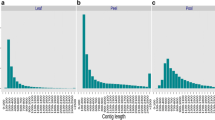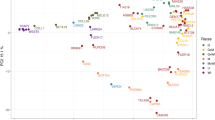Abstract
Sugarcane (Saccharum spp.) is a crop of substantial international significance for both food and fuel, however its highly polyploid nature challenges investigation of its genetic composition. Efforts to generate the full sugarcane genome sequence are underway, however in the meantime crop improvement efforts are somewhat limited by the lack of genome sequence resources available for physiological characterization. Low-coverage survey sequence data was generated and assembled for six sugarcane genotypes representing a range of significant S. spontaneum, S. officinarum, and S. hybrid cultivar accessions from around the world. These data were explored to investigate the composition of repetitive sequences and variations in chloroplast genome sequence, as well as assembled into a conglomerate monoploid genome sequence for polymorphism comparison between the genotypes. Almost half (47 %) of the inter-genomic polymorphisms analysed in these data represented poly-allelic variations which cannot be applied in traditional present/absent marker analysis, suggesting that new approaches are required to better understand and access genetic diversity within the Saccharum genus. These results support previous assertions that S. spontaneum is both less repetitive (62 % repetitive k-mers in Mandalay vs. 65 % in IJ76-514) and more highly polymorphic (17 % poly-alleles in Mandalay vs. 10 % poly-alleles in IJ76-514) than S. officinarum, with S. hybrids being intermediate between the two. However, contrary to previous analysis the monoploid genome size of S. spontaneum does not appear to differ significantly from that of S. officinarum as had been expected. This genomic survey assembly will be a very useful resource for sugarcane genomics in the absence of a monoploid or polyploid genome sequence, and will be made available upon request.


Similar content being viewed by others
Abbreviations
- SNP:
-
single nucleotide polymorphism
- 2GS:
-
second generation sequencing
- Bp:
-
base pairs
- WGS:
-
whole genome shotgun
References
Aitken KS, Jackson PA, McIntyre CL (2005) A combination of AFLP and SSR markers provides extensive map coverage and identification of homo(eo)logous linkage groups in a sugarcane cultivar. Theor Appl Genet 110:789–801. doi:10.1007/s00122-004-1813-7
Altschul SF, Gish W, Miller W et al (1990) Basic local alignment search tool. J Mol Biol 215:403–410. doi:10.1016/S0022-2836(05)80360-2
Baker P, Jackson PA, Aitken KS (2010) Bayesian estimation of marker dosage in sugarcane and other autopolyploids. Theor Appl Genet 120:1653–1672. doi:10.1007/s00122-010-1283-z
Berkman PJ, Visendi P, Lee HC et al (2013) Dispersion and domestication shaped the genome of bread wheat. Plant Biotechnol J 11:564–571. doi:10.1111/pbi.12044
Bundock PC, Casu RE, Henry RJ (2012) Enrichment of genomic DNA for polymorphism detection in a non-model highly polyploid crop plant. Plant Biotechnol J 10:657–667. doi:10.1111/j.1467-7652.2012.00707.x
Cox MP, Peterson DA, Biggs PJ (2010) SolexaQA: At-a-glance quality assessment of Illumina second-generation sequencing data. BMC Bioinforma 11:485. doi:10.1186/1471-2105-11-485
D’Hont A, Glaszmann J-C (2001) Sugarcane genome analysis with molecular markers: a first decade of research. In: Proceedings of the International Society of Sugar Cane Technologists, Brisbane, Australia, pp 556–559
D’Hont A, Ison D, Alix K et al (1998) Determination of basic chromosome numbers in the genus. Genome 41:221–225
Darling ACE (2004) Mauve: Multiple Alignment of Conserved Genomic Sequence With Rearrangements. Genome Res 14:1394–1403. doi:10.1101/gr.2289704
de Setta N, Metcalfe CJ, Cruz GMQ, et al. (2012) Noise or Symphony: Comparative Evolutionary Analysis of Sugarcane Transposable Elements with Other Grasses. 24:169–192. doi: 10.1007/978-3-642-31842-9_10
Garcia AAF, Mollinari M, Marconi TG et al (2013) SNP genotyping allows an in-depth characterisation of the genome of sugarcane and other complex autopolyploids. Sci Rep. doi:10.1038/srep03399
George AW, Aitken KS (2010) A New Approach for Copy Number Estimation in Polyploids. J Hered 101:521–524. doi:10.1093/jhered/esq034
Goodstein DM, Shu S, Howson R et al (2011) Phytozome: a comparative platform for green plant genomics. Nucleic Acids Res 40:D1178–D1186. doi:10.1093/nar/gkr944
Griffiths S, Sharp R, Foote TN et al (2006) Molecular characterization of Ph1 as a major chromosome pairing locus in polyploid wheat. Nature 439:749–752. doi:10.1038/nature04434
Grivet L, D’Hont A, Roques D et al (1996) RFLP mapping in cultivated sugarcane (Saccharum spp.): genome organization in a highly polyploid and aneuploid interspecific hybrid. Genetics 142:987–1000
Guindon S, Dufayard JF, Lefort V et al (2010) New Algorithms and Methods to Estimate Maximum-Likelihood Phylogenies: Assessing the Performance of PhyML 3.0. Systematic Biol 59:307–321. doi:10.1093/sysbio/syq010
Ha S, Moore PH, Heinz D et al (1999) Quantitative chromosome map of the polyploid Saccharum spontaneum by multicolor fluorescence in situ hybridization and imaging methods. Plant Mol Biol 39:1165–1173
Heslop-Harrison JSP, Schwarzacher T (2011) Organisation of the plant genome in chromosomes. The Plant J 66:18–33. doi:10.1111/j.1365-313X.2011.04544.x
Jannoo N, Grivet L, David J et al (2004) Differential chromosome pairing affinities at meiosis in polyploid sugarcane revealed by molecular markers. Heredity 93:460–467. doi:10.1038/sj.hdy.6800524
Jannoo N, Grivet L, Chantret N et al (2007) Orthologous comparison in a gene-rich region among grasses reveals stability in the sugarcane polyploid genome. Plant J 50:574–585. doi:10.1111/j.1365-313X.2007.03082.x
Jenczewski E, Eber F, Grimaud A et al (2003) PrBn, a major gene controlling homeologous pairing in oilseed rape (Brassica napus) haploids. Genetics 164:645–653
Kazakoff SH, Imelfort M, Edwards D et al (2012) Capturing the Biofuel Wellhead and Powerhouse: The Chloroplast and Mitochondrial Genomes of the Leguminous Feedstock Tree Pongamia pinnata. PLoS One 7:e51687. doi:10.1371/journal.pone.0051687.g004
Kim C, Lee T-H, Compton RO et al (2012) A genome-wide BAC end-sequence survey of sugarcane elucidates genome composition, and identifies BACs covering much of the euchromatin. Plant Mol Biol 81:139–147. doi:10.1007/s11103-012-9987-x
Korf I (2004) Gene finding in novel genomes. BMC Bioinforma 5:59. doi:10.1186/1471-2105-5-59
Kurtz S, Narechania A, Stein JC, Ware D (2008) A new method to compute K-mer frequencies and its application to annotate large repetitive plant genomes. BMC Genomics 9:517. doi:10.1186/1471-2164-9-517
Li H, Durbin R (2009) Fast and accurate short read alignment with Burrows-Wheeler transform. Bioinformatics 25:1754–1760. doi:10.1093/bioinformatics/btp324
Li H, Durbin R (2010) Fast and accurate long-read alignment with Burrows-Wheeler transform. Bioinformatics 26:589–595. doi:10.1093/bioinformatics/btp698
Li R, Yu C, Li Y et al (2009) SOAP2: an improved ultrafast tool for short read alignment. Bioinformatics 25:1966–1967. doi:10.1093/bioinformatics/btp336
McFadden ES, Sears ER (1946) The origin of Triticum spelta and its free-threshing hexaploid relatives. Journal of Heredity
Mudge J, Andersen WR, Kehrer RL, Fairbanks DJ (1996) A RAPD genetic map of Saccharum officinarum. Crop Sci 36:1362–1366
Ouyang S (2004) The TIGR Plant Repeat Databases: a collective resource for the identification of repetitive sequences in plants. Nucleic Acids Res 32:360D–363. doi:10.1093/nar/gkh099
Paterson AH, Bowers JE, Bruggmann R et al (2009) The Sorghum bicolor genome and the diversification of grasses. Nature 457:551–556. doi:10.1038/nature07723
Piperidis G, Piperidis N, D’Hont A (2010) Molecular cytogenetic investigation of chromosome composition and transmission in sugarcane. Mol Genet Genomics 284:65–73. doi:10.1007/s00438-010-0546-3
Posada D, Crandall KA (1998) MODELTEST: testing the model of DNA substitution
Raboin LM, Oliveira KM, Lecunff L et al (2006) Genetic mapping in sugarcane, a high polyploid, using bi-parental progeny: identification of a gene controlling stalk colour and a new rust resistance gene. Theor Appl Genet 112:1382–1391. doi:10.1007/s00122-006-0240-3
Reffay N, Jackson PA, Aitken KS et al (2005) Characterisation of genome regions incorporated from an important wild relative into Australian sugarcane. Mol Breeding 15:367–381. doi:10.1007/s11032-004-7981-y
Rosenfeld JA, Mason CE, Smith TM (2012) Limitations of the Human Reference Genome for Personalized Genomics. PLoS One 7:e40294. doi:10.1371/journal.pone.0040294.g001
Schnable PS, Ware D, Fulton RS et al (2009) The B73 maize genome: complexity, diversity, and dynamics. Science 326:1112–1115. doi:10.1126/science.1178534
Serang O, Mollinari M, Garcia AAF (2012) Efficient Exact Maximum a Posteriori Computation for Bayesian SNP Genotyping in Polyploids. PLoS One 7:e30906. doi:10.1371/journal.pone.0030906.t001
Silva Figueira TRE, Okura V, da Silva FR et al (2012) A BAC library of the SP80-3280 sugarcane variety (saccharum sp.) and its inferred microsynteny with the sorghum genome. BMC Res Notes 5:185
Soltis DE, Albert VA, Leebens-Mack J et al (2009) Polyploidy and angiosperm diversification. Am J Bot 96:336–348. doi:10.3732/ajb.0800079
Steiger D, Nagai C, Moore P, Morden C (2002) AFLP analysis of genetic diversity within and among Coffea arabica cultivars - Springer. … and applied genetics
Swofford DL (2003) PAUP*. Phylogenetic Analysis Using Parsimony (*and Other Methods). Version 4. 2003. Sunderland, Massachusetts
Takahashi S, Furukawa T, Asano T et al (2005) Very close relationship of the chloroplast genomes among Saccharum species. Theor Appl Genet 110:1523–1529. doi:10.1007/s00122-005-1990-z
Tomkins JP, Yu Y, Miller-Smith H et al (1999) A bacterial artificial chromosome library for sugarcane. Theor Appl Genet 99:419–424. doi:10.1007/s001220051252
U N (1935) Genome analysis in Brassica with special reference to the experimental formation of B. napus and peculiar mode of fertilization. Japan J Bot 7:389–452
Wang J, Roe B, Macmil SL et al (2010) Microcollinearity between autopolyploid sugarcane and diploid sorghum genomes. BMC Genomics 11:261. doi:10.1186/1471-2164-11-261
Wang X, Wang H, Wang J et al (2011) The genome of the mesopolyploid crop species Brassica rapa. Nat Genet 43:1035–1039. doi:10.1038/ng.919
Wanjugi H, Coleman-Derr D, Huo N et al (2009) Rapid development of PCR-based genome-specific repetitive DNA junction markers in wheat. Genome 52:576–587. doi:10.1139/G09-033
Weigel D, Mott R (2009) The 1001 genomes project for Arabidopsis thaliana. Genome Biol 10:107. doi:10.1186/gb-2009-10-5-107
Wicker T, Narechania A, Sabot F et al (2008) Low-pass shotgun sequencing of the barley genome facilitates rapid identification of genes, conserved non-coding sequences and novel repeats. BMC Genomics 9:518. doi:10.1186/1471-2164-9-518
Wolfe KH (2001) Yesterday’s polyploids and the mystery of diploidization. Nat Rev Genet 2:333–341. doi:10.1038/35072009
Young HA, Lanzatella CL, Sarath G, Tobias CM (2011) Chloroplast Genome Variation in Upland and Lowland Switchgrass. PLoS One 6:e23980. doi:10.1371/journal.pone.0023980.t004
Zerbino DR, Birney E (2008) Velvet: Algorithms for de novo short read assembly using de Bruijn graphs. Genome Res 18:821–829. doi:10.1101/gr.074492.107
Acknowledgements
The authors gratefully acknowledge funding support from the CRC for Sugar Industry Innovation through Biotechnology and CSIRO’s Office of the Chief Executive. The authors further acknowledge Donna Glassop and Kenji Osabe for their valuable feedback on the manuscript.
Author information
Authors and Affiliations
Corresponding author
Additional information
Communicated by: Dr. Paul H. Moore
Electronic supplementary material
Below is the link to the electronic supplementary material.
ESM 1
(XLSX 212 kb)
Supplementary Figure 1
Numerical representation of repeat categories within six sugarcane genotypes (DOCX 15 kb)
Supplementary Figure 2
Phylogeny of six sugarcane genotypes based on chloroplast sequences. Sorghum was used as an outgroup in this comparison. (DOCX 43 kb)
Supplementary Figure 3
Normalised monoploid coverage histograms for the six genotypes (DOCX 507 kb)
Rights and permissions
About this article
Cite this article
Berkman, P.J., Bundock, P.C., Casu, R.E. et al. A Survey Sequence Comparison of Saccharum Genotypes Reveals Allelic Diversity Differences. Tropical Plant Biol. 7, 71–83 (2014). https://doi.org/10.1007/s12042-014-9139-3
Received:
Accepted:
Published:
Issue Date:
DOI: https://doi.org/10.1007/s12042-014-9139-3




